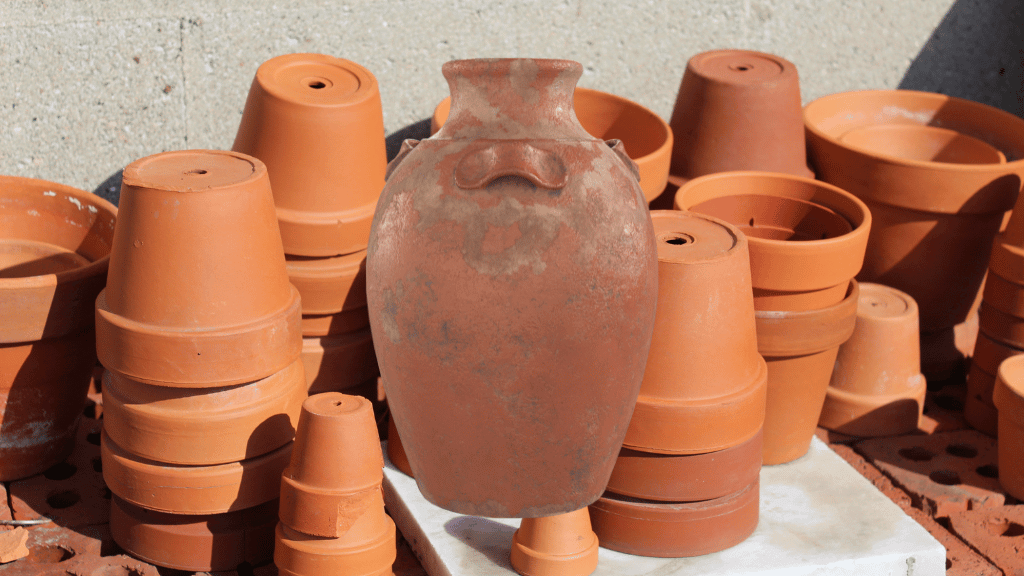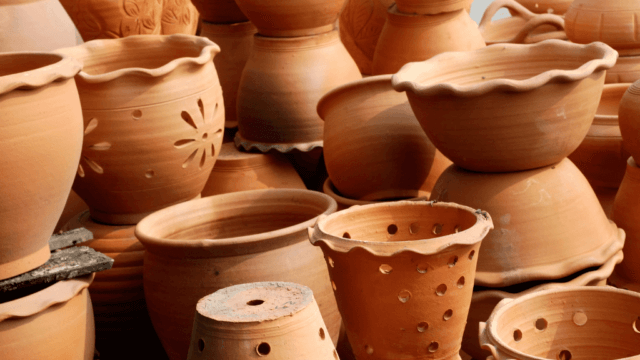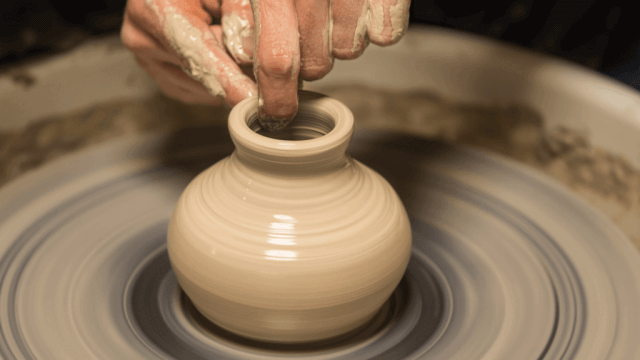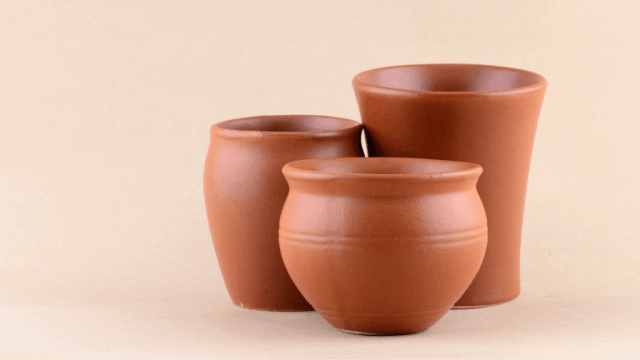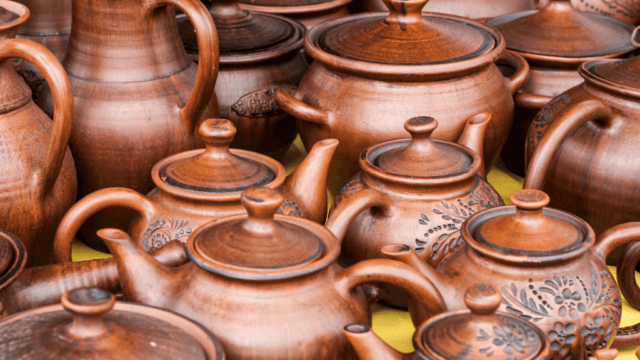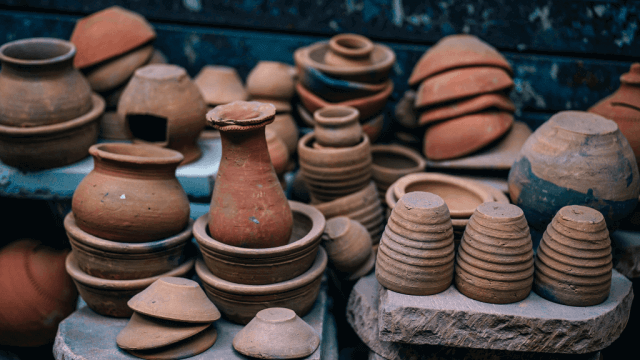Terracotta pottery refers to a type of ceramicware made from red-brown, porous clay that has been fired at a relatively low temperature.
Known for its rich, earthy hue and unglazed finish, terracotta pottery has been widely used throughout history for functional items such as pots, roof tiles, and sculptures.
Understanding Terracotta Pottery
Terracotta pottery is a form of ceramicware crafted from red-brown, porous clay, which is known for its earthy hue and unglazed finish.
Derived from the Italian words ‘terra’ (earth) and ‘cotta’ (cooked), terracotta has been utilized for various purposes throughout history, such as functional items, pots, roof tiles, and sculptures.
The Basics of Terracotta Clay
Terracotta clay consists primarily of iron-bearing earthenware that results in a deep reddish-brown hue when fired.
Requiring relatively low firing temperatures, around 1000-1200°C (1832-2192°F), terracotta becomes firm and durable, albeit porous.
Due to its porous nature, it is often used for planters, as it allows the controlled airflow to plant roots and aids in moisture retention.
Composition of Terracotta Clay
Frequently found in riverbeds and mineral-rich soil, terracotta clay consists of kaolinite minerals, iron, and other impurities that impact color and texture.
The iron content directly affects the distinct red-brown appearance of terracotta, while the presence of minerals contributes to its durability and other characteristics upon firing.
Various Forms of Terracotta Pottery
Beyond its use in gardening and planters, terracotta pottery exhibits versatility in the creation of various functional and decorative items, such as:
- Roof tiles and bricks: Utilized extensively in architecture, terracotta tiles provide durability, weather resistance, and thermal insulation.
- Sculptures: Terracotta has been employed to create figurines and statues for thousands of years, featuring prominently in ancient Greek, Roman, and Chinese art.
- Cookware and tableware: Its excellent heat distribution properties make terracotta ideal for cookware, such as cazuelas, tajines, and baking dishes.
Terracotta tableware includes plates, bowls, and drinking vessels.
Working with Terracotta Clay
Creating terracotta pottery involves several essential steps:
- Preparation: Terracotta clay is thoroughly kneaded to eliminate air bubbles and ensure homogeneity.
- Forming: The clay is shaped using techniques such as hand-building, wheel-throwing, or molding.
- Drying: The formed piece is allowed to dry completely for several days, depending on its size and thickness.
- Firing: The dried pottery is fired in a kiln at the appropriate temperature for terracotta, usually between 1000-1200°C (1832-2192°F).
- Optional Glazing: If a glossy finish is desired, the piece can be glazed after firing and fired a second time to set the glaze.
Significance of Terracotta Pottery in History
Terracotta pottery has a long and storied history, dating as far back as 24,000 BC.
It has been discovered across numerous civilizations, from ancient Egypt, Mesopotamia, and China to the Greek, Roman, and Pre-Columbian American cultures.
As one of the oldest forms of pottery, terracotta has played a crucial role in archaeology, providing valuable insights into various cultures and their customs, materials, and techniques.
Advantages of Using Terracotta Pottery
Terracotta pottery offers numerous benefits that make it a popular choice in various applications:
- Durability: While not as strong as stoneware or porcelain, terracotta is still fairly sturdy and can endure the test of time when properly cared for.
- Thermal properties: Terracotta conducts and retains heat well, making it an ideal material for cookware and floor tiles.
- Moisture regulation and breathability: Terracotta’s porous nature enables it to absorb and regulate moisture, a valuable quality for planters, as well as for certain architectural applications.
- Eco-friendliness: As a natural, organic material, terracotta poses minimal environmental impact compared to synthetic materials.
How to Care for Terracotta Pottery
Proper care is essential for maintaining the longevity and aesthetic appeal of terracotta pottery:
- Cleaning: Clean unglazed terracotta with a damp cloth, warm water, and mild soap.
Avoid using harsh chemicals or abrasive cleaners, as they may damage the surface.
For glazed terracotta, standard dishwashing methods are acceptable.
- Storage: Store terracotta pottery in a clean, dry, and well-ventilated area.
Protect from extreme temperatures, as dramatic fluctuations can lead to cracking.
- Handling and usage: Handle terracotta pieces gently to prevent chipping or breakage.
For cookware, always use silicone, wooden, or plastic utensils, as metal may scratch the surface.
The Revival of Terracotta Pottery in Modern Art
Contemporary artists and potters are rekindling an interest in terracotta pottery, experimenting with traditional techniques, and infusing them with innovative ideas.
The vibrant art scene has embraced terracotta for its earthy charm and connection to history, leading to exciting new forms of functional and decorative ceramics alongside a revival of ancient practices in modern pottery studios.
Frequently Asked Questions about Terracotta Pottery
Gain further insight into terracotta pottery with answers to some common questions on the subject.
This section delves deeper into the characteristics, uses, and care of terracotta to help you better understand and appreciate this unique ceramic material.
What makes terracotta pottery different from other types of ceramicware?
Terracotta pottery is made from red-brown, porous earthenware clay fired at low temperatures (1000-1200°C or 1832-2192°F).
It is distinguishable by its earthy hue and unglazed surface and is known for its ability to regulate moisture, making it suitable for planters, tiles, sculptures, and cookware.
Can terracotta pottery be used for cooking?
Yes, terracotta is an excellent material for cooking due to its outstanding heat retention and distribution properties.
It is commonly used to create cookware such as cazuelas, tajines, and baking dishes.
Always ensure that the terracotta cookware is made from food-safe clay and free of harmful substances.
Does terracotta pottery require any special care?
Unglazed terracotta pottery should be cleaned with a damp cloth, warm water, and mild soap, avoiding harsh chemicals and abrasive cleaners.
Glazed terracotta can be cleaned using standard dishwashing methods.
Store the pottery in a dry, well-ventilated area, and protect it from extreme temperature fluctuations to prevent cracking.
Is terracotta pottery suitable for outdoor use?
While terracotta pottery is weather-resistant, prolonged exposure to moisture, freezing temperatures, or extreme heat can cause damage.
For outdoor use, ensure that the pottery has proper drainage and consider using a protective sealer to enhance its durability and resistance to natural elements.
Can terracotta pottery be painted?
Yes, terracotta pottery can be painted, though it is essential to prime the surface first to ensure proper adhesion.
For best results, use acrylic or latex-based paints specifically designed for pottery or outdoor use.
Apply a clear sealant to protect the paint job and prolong its longevity.
